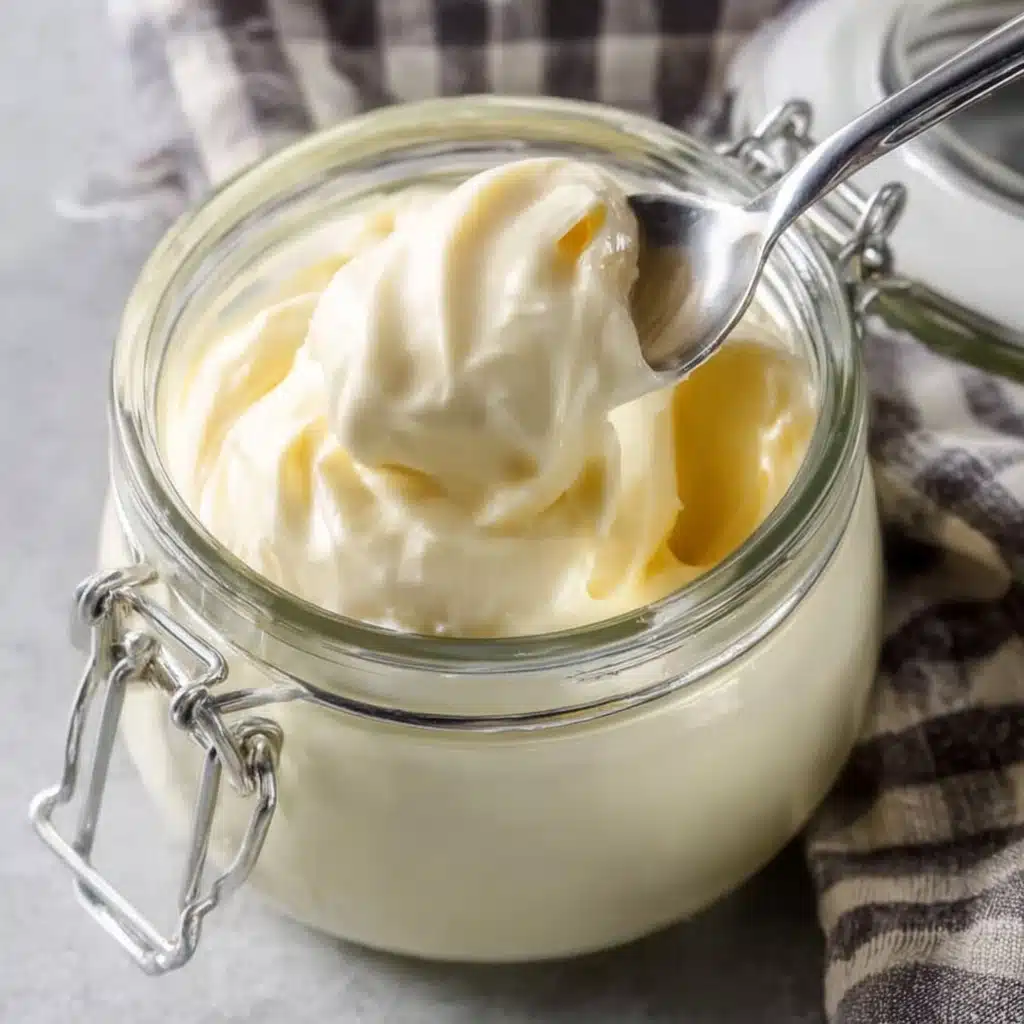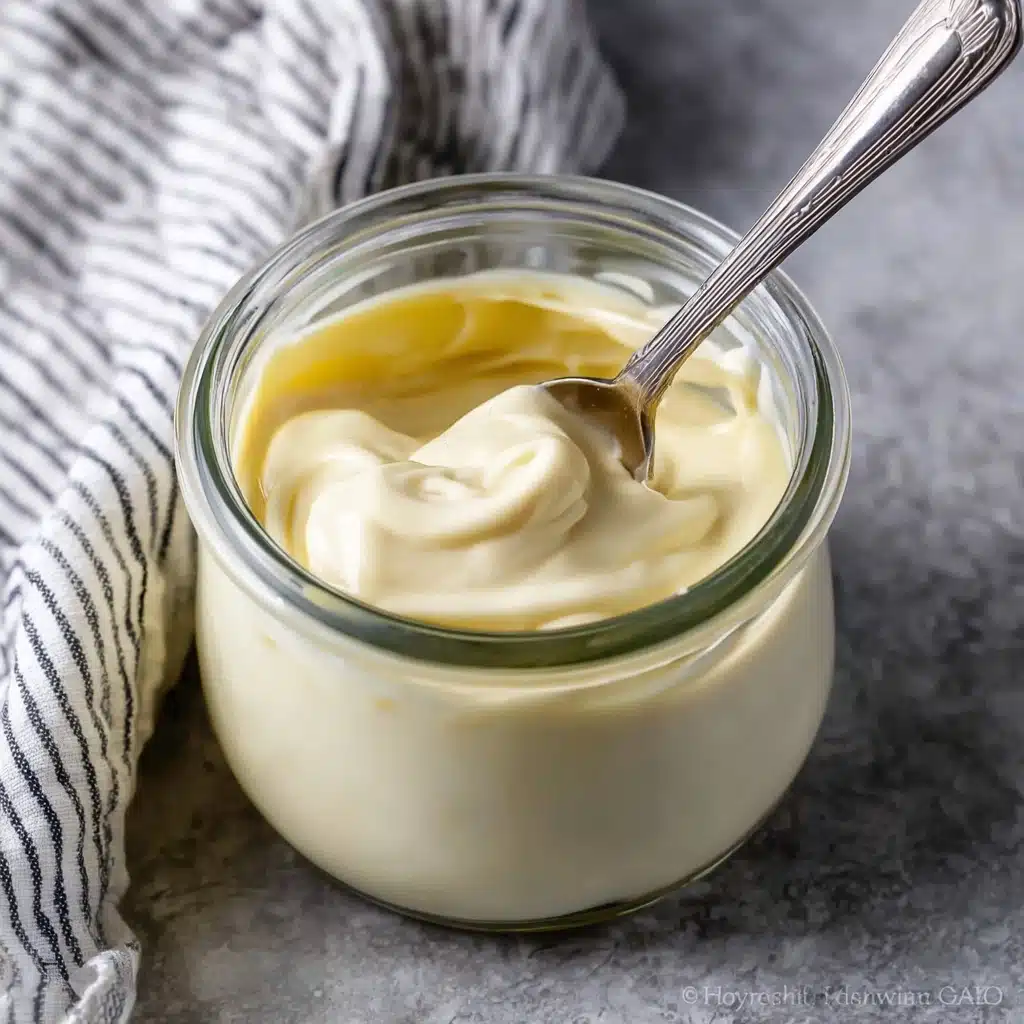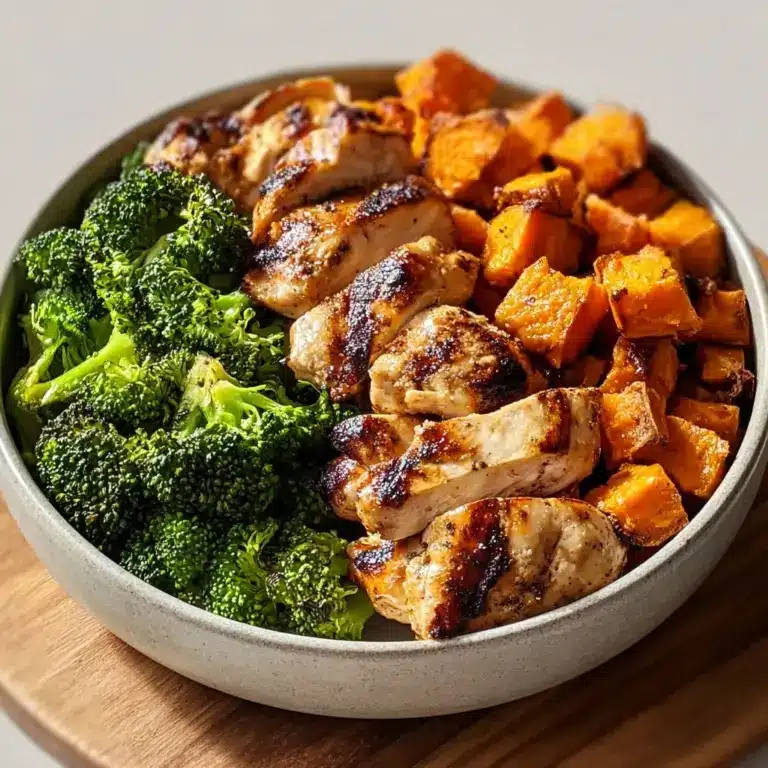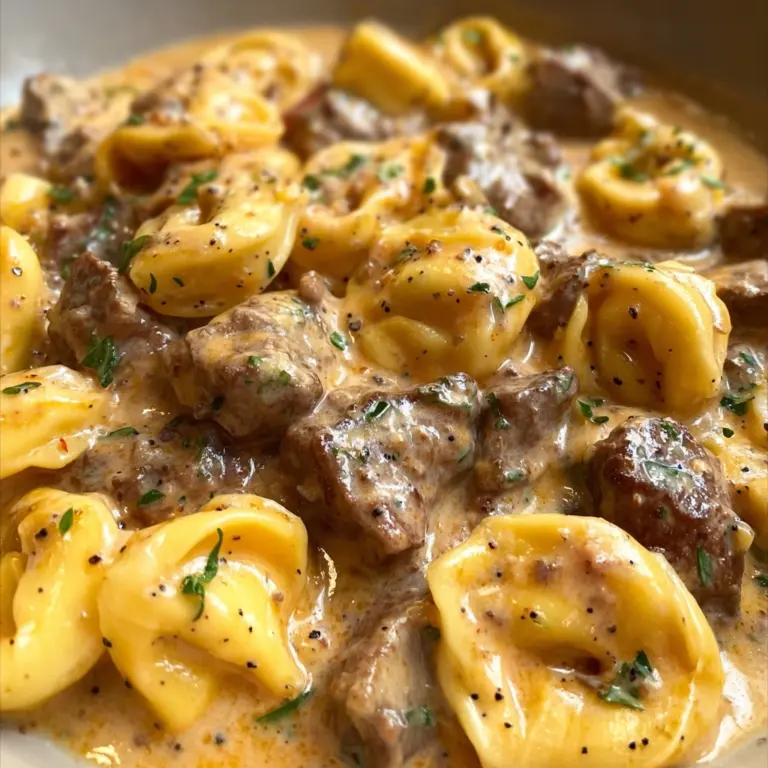Homemade Mayonnaise Recipe
If you’ve ever wished for a rich, creamy, and utterly fresh condiment that can transform any sandwich, salad, or snack, then homemade mayonnaise is your new best friend. This Homemade Mayonnaise recipe is not only incredibly simple to whip up but also boasts a delightful balance of tanginess and smooth texture that store-bought versions can only dream of. The magic lies in using fresh ingredients that come together in minutes to create a luscious, velvety spread perfect for elevating your everyday dishes.

Ingredients You’ll Need
Gathering the right ingredients is key to making your Homemade Mayonnaise shine. Each component plays a vital role in flavor, texture, or color, combining to produce that perfect creamy consistency.
- 1 large egg: Provides richness and acts as the natural emulsifier to bind the mixture.
- 1 Tbsp lemon juice: Adds a bright, zesty tang that cuts through the richness beautifully.
- 1 tsp white vinegar: Enhances the acidity and helps balance the flavors.
- ½ tsp ground mustard (or Dijon mustard): Offers a subtle depth and slight kick to round out the taste.
- ¼ tsp salt: Brings all the flavors into perfect harmony.
- 1 cup avocado oil (or vegetable/light olive oil): Delivers a smooth texture and a mild flavor that won’t overpower the mayonnaise.
How to Make Homemade Mayonnaise
Step 1: Combine the Base Ingredients
Start by placing your egg, lemon juice, white vinegar, ground mustard, and salt into a bowl, mason jar, or the cup from your immersion blender. Blend these ingredients together until you achieve a smooth and creamy mixture. This step is crucial to create a flavorful foundation for your mayonnaise.
Step 2: Emulsify with Oil
With the immersion blender running, slowly drizzle in the avocado oil. This gradual addition helps the oil emulsify perfectly, turning your mixture into that luscious, creamy mayonnaise. Be patient and steady—that’s the secret to a beautifully stable emulsion.
Step 3: Adjust and Perfect
Give your Homemade Mayonnaise a taste. If it feels too oily or overly creamy, simply add a bit more lemon juice or salt to tailor the flavor and texture to your liking. Once you’ve reached that perfect balance, your mayonnaise is ready to enjoy or store for later.
How to Serve Homemade Mayonnaise

Garnishes
Sprinkle freshly chopped herbs like dill, chives, or parsley on top of your mayonnaise to add a vibrant burst of flavor and color. A pinch of smoked paprika or a few drops of hot sauce can also add a delightful twist.
Side Dishes
This Homemade Mayonnaise pairs wonderfully with crispy fries, fresh vegetable sticks, or as a creamy addition to potato or coleslaw salads. It’s also a stellar complement to grilled chicken, fish, or sandwiches, bringing moistness and richness to every bite.
Creative Ways to Present
Serve your mayonnaise as a flavored dip by mixing in garlic, roasted red peppers, or avocado for something extra special. You can also pipe it onto appetizers or use it as a base for contrasting sauces to impress your guests at parties.
Make Ahead and Storage
Storing Leftovers
Keep your Homemade Mayonnaise in an airtight container in the refrigerator, where it will stay fresh for up to one week. Make sure to always use a clean utensil to avoid contamination and maintain that fresh taste.
Freezing
Freezing homemade mayonnaise is not recommended, as the texture tends to separate and become grainy once thawed. For the best quality, enjoy it fresh or refrigerated within the suggested timeframe.
Reheating
There’s no need to reheat mayonnaise. Enjoy it chilled for the creamiest texture and best flavor, whether it’s dolloped onto a sandwich or stirred into a salad.
FAQs
Is homemade mayonnaise safe to eat with raw egg?
Yes, using fresh, properly stored eggs reduces the risk. For extra safety, you can use pasteurized eggs. Always consume homemade mayonnaise within a week and keep it refrigerated.
Can I use other oils besides avocado oil?
Absolutely! Light olive oil, vegetable oil, or grapeseed oil work well. Avoid strong-flavored oils like extra virgin olive oil as they can overpower the delicate balance.
What can I do if my mayonnaise doesn’t thicken?
This usually happens if the oil is added too quickly. Try whisking in a teaspoon of warm water or starting over with a fresh egg yolk and slowly incorporate the failed mixture.
How can I make my mayonnaise more flavorful?
Experiment with adding herbs, garlic, or spices like smoked paprika or cayenne. A bit of honey or mustard can also bring exciting flavor profiles to your base mayonnaise.
Can I make Homemade Mayonnaise without an immersion blender?
Yes, you can whisk by hand, though it requires more effort and patience. Alternatively, a food processor or stand mixer will also do the job well.
Final Thoughts
There’s nothing quite like the satisfaction of creating your very own Homemade Mayonnaise—its fresh taste, velvety texture, and customizable flavor make it a must-have in your kitchen repertoire. Once you try making it yourself, you’ll never want to reach for the store-bought jars again. Trust me, your sandwiches, salads, and snacks will thank you endlessly!
PrintHomemade Mayonnaise Recipe
This homemade mayonnaise recipe is a simple and delicious way to create creamy, fresh mayo using basic ingredients like egg, lemon juice, vinegar, and avocado oil. It’s perfect for sandwiches, dressings, and dips, offering a customizable and preservative-free alternative to store-bought versions.
- Prep Time: 5 minutes
- Cook Time: 0 minutes
- Total Time: 5 minutes
- Yield: About 1 cup 1x
- Category: Condiment
- Method: Blending/Emulsifying
- Cuisine: American
- Diet: Low Salt
Ingredients
Wet Ingredients
- 1 large egg
- 1 Tbsp lemon juice
- 1 tsp white vinegar
- 1 cup avocado oil (or vegetable oil or light olive oil)
Dry Ingredients
- ½ tsp ground mustard (or ½ tsp Dijon mustard)
- ¼ tsp salt
Instructions
- Combine Base Ingredients: Add 1 large egg, 1 tablespoon lemon juice, 1 teaspoon white vinegar, ½ teaspoon ground mustard, and ¼ teaspoon salt into a bowl, mason jar, or the cup compatible with your immersion blender. Blend until smooth and creamy to form the base of your mayonnaise.
- Slowly Incorporate Oil: While your immersion blender is running on low, slowly drizzle in 1 cup of avocado oil. This gradual addition allows the oil to emulsify with the egg mixture, creating a thick, creamy mayonnaise texture. Continue blending until fully combined and smooth.
- Adjust Flavor and Consistency: Taste your mayonnaise. If it seems too rich or oily, add a little more lemon juice or salt and blend briefly again to adjust the flavor and reach your preferred consistency.
- Store and Serve: Transfer the mayonnaise to an airtight container and refrigerate. Use within one week for best freshness. Enjoy as a spread, dip, or dressing base.
Notes
- Use fresh, high-quality eggs to ensure safety and the best flavor.
- Maintain a slow drizzle of oil while blending to achieve proper emulsification and prevent separation.
- You can substitute avocado oil with vegetable oil or light olive oil for different flavors.
- Store homemade mayo in the refrigerator and consume within 7 days to ensure safety as it contains raw egg.
- Adding mustard helps stabilize the emulsion and adds subtle flavor.
- If the mayonnaise breaks (separates), start with a fresh egg yolk and slowly whisk the broken mayo into it to rescue the mixture.
Nutrition
- Serving Size: 1 tablespoon (15g)
- Calories: 90
- Sugar: 0.1g
- Sodium: 90mg
- Fat: 10g
- Saturated Fat: 1.5g
- Unsaturated Fat: 7.5g
- Trans Fat: 0g
- Carbohydrates: 0.1g
- Fiber: 0g
- Protein: 0.2g
- Cholesterol: 5mg
Keywords: homemade mayonnaise, DIY mayo, avocado oil mayonnaise, easy mayonnaise recipe, creamy mayo, fresh mayo, no preservatives








